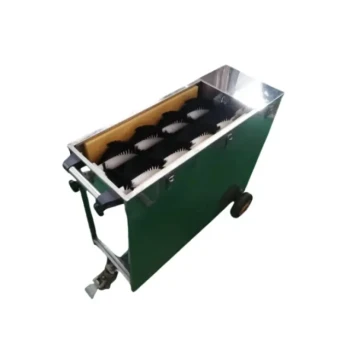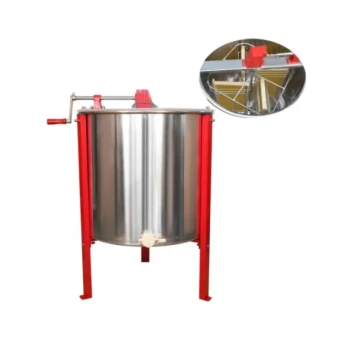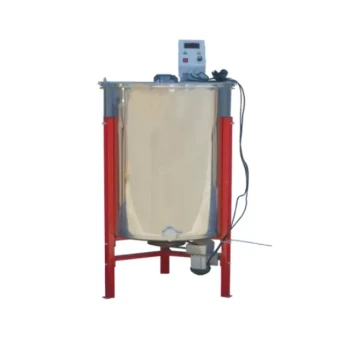At its core, the maintenance and upkeep of a Flow Hive involve all the standard practices of traditional beekeeping. While the honey extraction process is simplified, the fundamental responsibility of caring for a living colony of bees remains the same. This includes regular inspections for pests and diseases, ensuring the queen is healthy, and managing the colony's space and resources.
The central takeaway is this: A Flow Hive changes the task of honey harvesting, but it does not change the essential work of beekeeping. The health of the bees is paramount, and this requires the same level of diligence, inspection, and care as any other type of beehive.
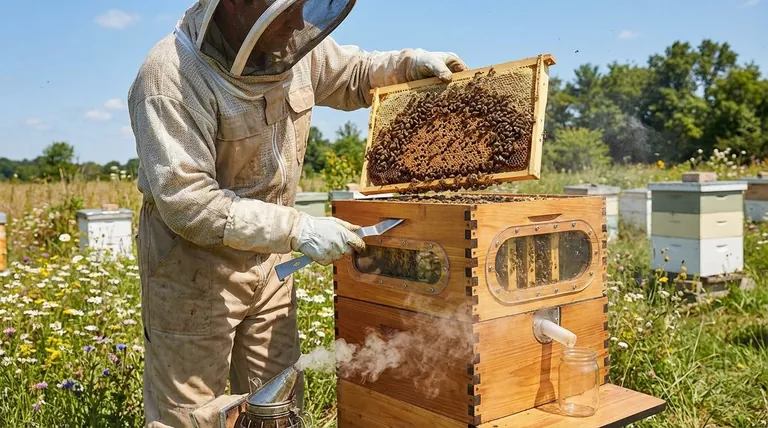
The Core Principle: You Are a Beekeeper First
Before addressing the specific hardware, it's critical to understand that you are managing a living ecosystem. The box, whether it's a traditional Langstroth or a Flow Hive, is just the bees' home.
The Focus is Colony Health
The success of any hive is measured by the health and productivity of its colony. Maintenance tasks are not chores; they are vital actions to support the bees' natural cycle and protect them from threats.
Hardware vs. Husbandry
The Flow Hive is an innovative piece of hardware for honey storage and extraction. Beekeeping, however, is animal husbandry. Your maintenance schedule must prioritize the needs of the bees over the function of the equipment.
Routine Hive Inspections: Your Essential Checklist
Regardless of the hive type, you must perform regular inspections. The frequency will vary by season and region, but the core checklist remains consistent.
Assessing Colony Health and Temperament
A calm, active colony is often a healthy one. During an inspection, you are observing the bees' behavior, listening for a steady hum, and ensuring the population seems robust.
Checking for Pests and Diseases
This is the most critical maintenance task. You must proactively look for threats, the most significant of which is the Varroa mite. Early detection and proper treatment are essential to prevent a colony collapse. Other issues to watch for include hive beetles, wax moths, and signs of brood diseases.
Monitoring the Brood and Queen
A healthy hive has a productive queen. You will need to inspect the brood chamber (the lower boxes) to find evidence of the queen's work. Look for a consistent pattern of eggs, larvae, and capped brood, which indicates she is laying well.
Managing Space and Resources
Bees need adequate space to expand the colony and store resources like pollen and nectar. Part of your maintenance is adding or removing boxes (supers) as needed to prevent overcrowding, which can lead to swarming.
Flow Frame Specific Maintenance
The Flow Frames themselves require minimal but important upkeep to ensure they function correctly and last for many seasons.
Cleaning After Harvest
After harvesting, the bees will typically clean the cells. However, it is good practice to remove the Flow Super at the end of the season for a more thorough cleaning with warm water to remove any wax and propolis buildup.
Proper Storage
During winter or periods when the frames are not on the hive, they must be stored in a dry, pest-free location. This prevents damage from wax moths, rodents, and moisture.
Understanding the Trade-offs
The convenience of the Flow Hive is clear, but it's important to approach it with a balanced perspective.
The Risk of "Set and Forget"
The ease of harvesting can inadvertently lead new beekeepers to neglect full hive inspections. It is easy to focus on the honey super and forget that the real engine of the hive is the brood box below, which requires regular attention.
Connection to the Hive
Traditional honey harvesting is a messy but intimate process that involves contact with bees, wax, and honey. Some beekeepers feel the hands-off nature of the Flow system can create a slight disconnect from the natural rhythms of the hive.
Reliance on a System
The specialized plastic frames are the core of the system. While durable, you are dependent on this specific technology, whereas traditional beekeeping equipment is more universally interchangeable.
Making the Right Choice for Your Goal
Your maintenance approach should align with your primary objective as a beekeeper.
- If your primary focus is convenient, mess-free honey harvesting: Prioritize keeping the Flow Frame mechanisms clean and functional, but commit to a strict schedule of brood box inspections for colony health.
- If your primary focus is the long-term health of the bees: Treat the hive as a standard Langstroth hive that happens to have a special super, focusing your energy on integrated pest management and brood health above all else.
- If your primary focus is a balanced, hands-on hobby: Use the Flow Frames for their convenience but make time for traditional hive work, ensuring the technology supports, rather than replaces, your beekeeping knowledge and skills.
Ultimately, successful beekeeping is defined by dedicated care for the colony, and the Flow Hive is simply one tool to aid you on that journey.
Summary Table:
| Maintenance Category | Key Tasks |
|---|---|
| Colony Health | Regular inspections, checking for pests (Varroa mites), monitoring the queen, managing space. |
| Flow Frame Care | Cleaning frames after harvest with warm water, proper off-season storage. |
| Beekeeper's Role | Prioritizing bee health over hardware, avoiding a 'set and forget' mindset. |
Ready to elevate your beekeeping operation? Proper maintenance is key to a thriving apiary. At HONESTBEE, we supply commercial apiaries and beekeeping equipment distributors with the durable, wholesale-focused supplies needed for effective hive management. From essential tools for inspections to equipment for large-scale honey harvesting, we have what you need to succeed.
Contact our expert team today to discuss your wholesale needs and discover how HONESTBEE can support your business's growth and efficiency.
Visual Guide
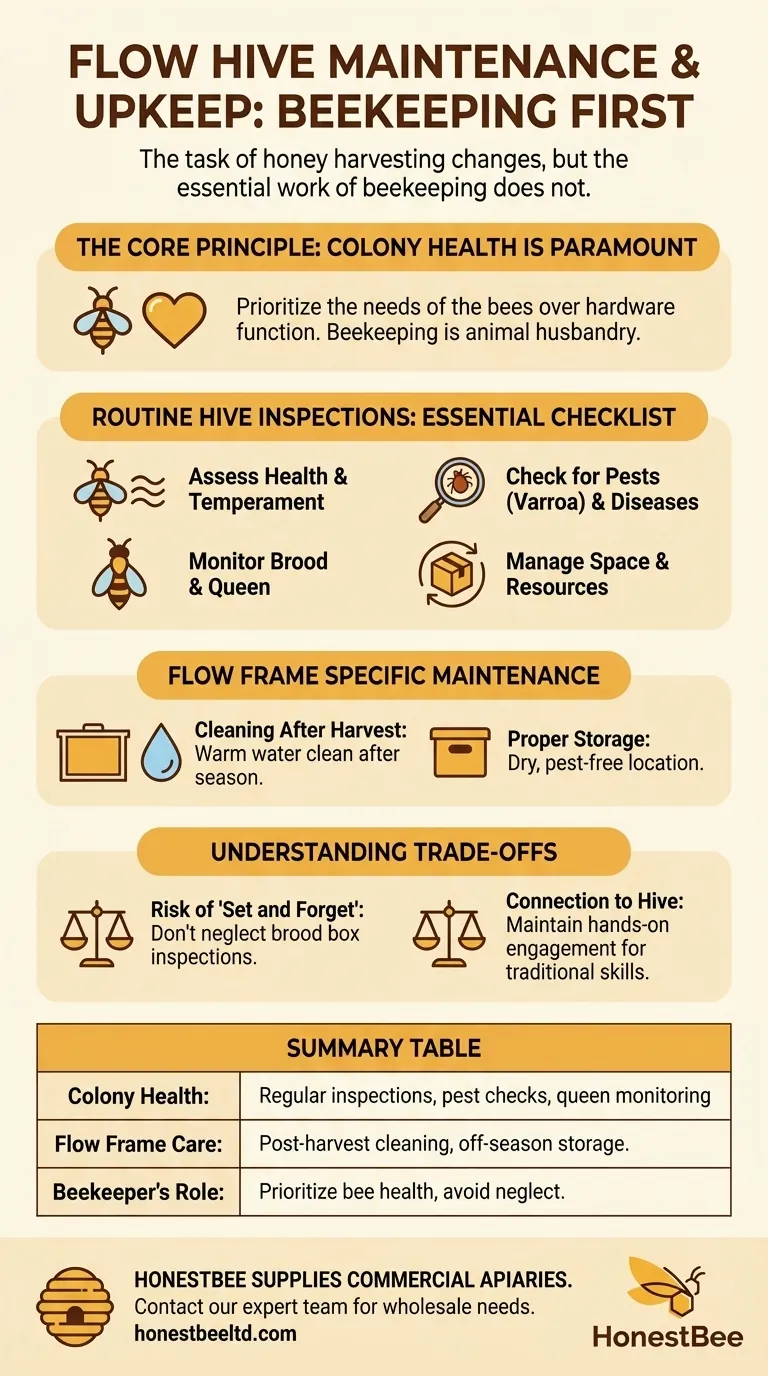
Related Products
- HONESTBEE Professional Long Handled Hive Tool with Precision Cutting Blade
- Wholesales Dadant Size Wooden Bee Hives for Beekeeping
- Commercial Grade Vertical Electric Bee Sweeper for Bee Removal
- Professional Grade Foldable Beehive Handles
- Professional Hive Top Bee Feeder for Beekeeping
People Also Ask
- What are the basic tools for beekeeping? Essential Starter Kit for Safe & Successful Hive Management
- How can a hive tool be used to remove propolis and burr comb? Master Hive Maintenance for a Healthy Colony
- Why do hive tools have a hole? Unlock the Secret to Efficient Beekeeping
- What are the features of a regular hive tool? The Essential Multi-Tool for Every Beekeeper
- What tools are used for cleaning frames? A Beekeeper's Simple 4-Tool Guide


